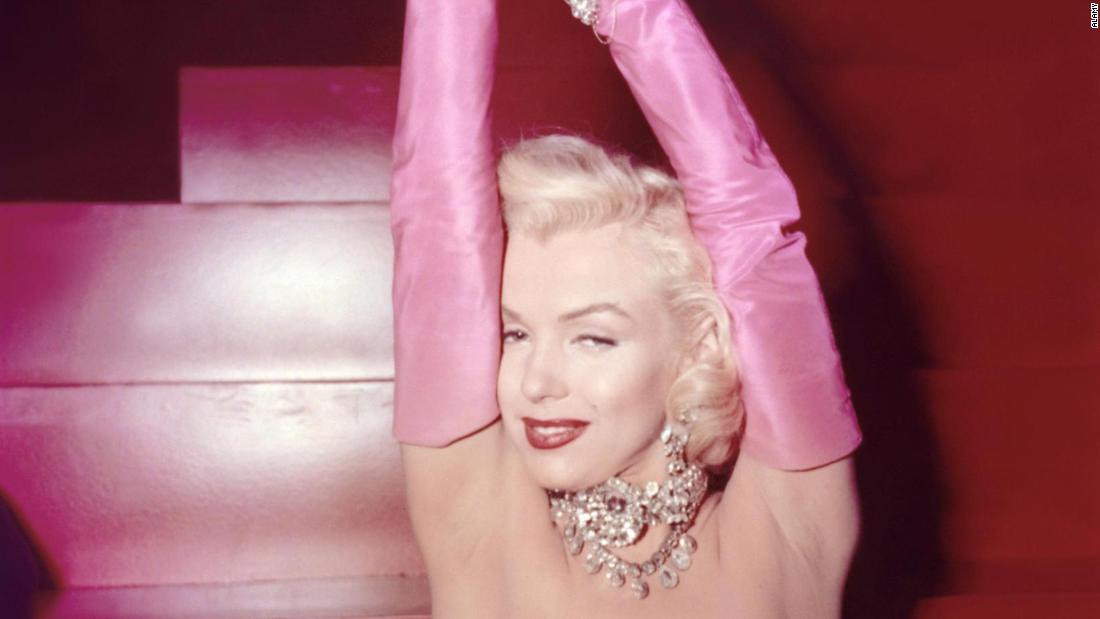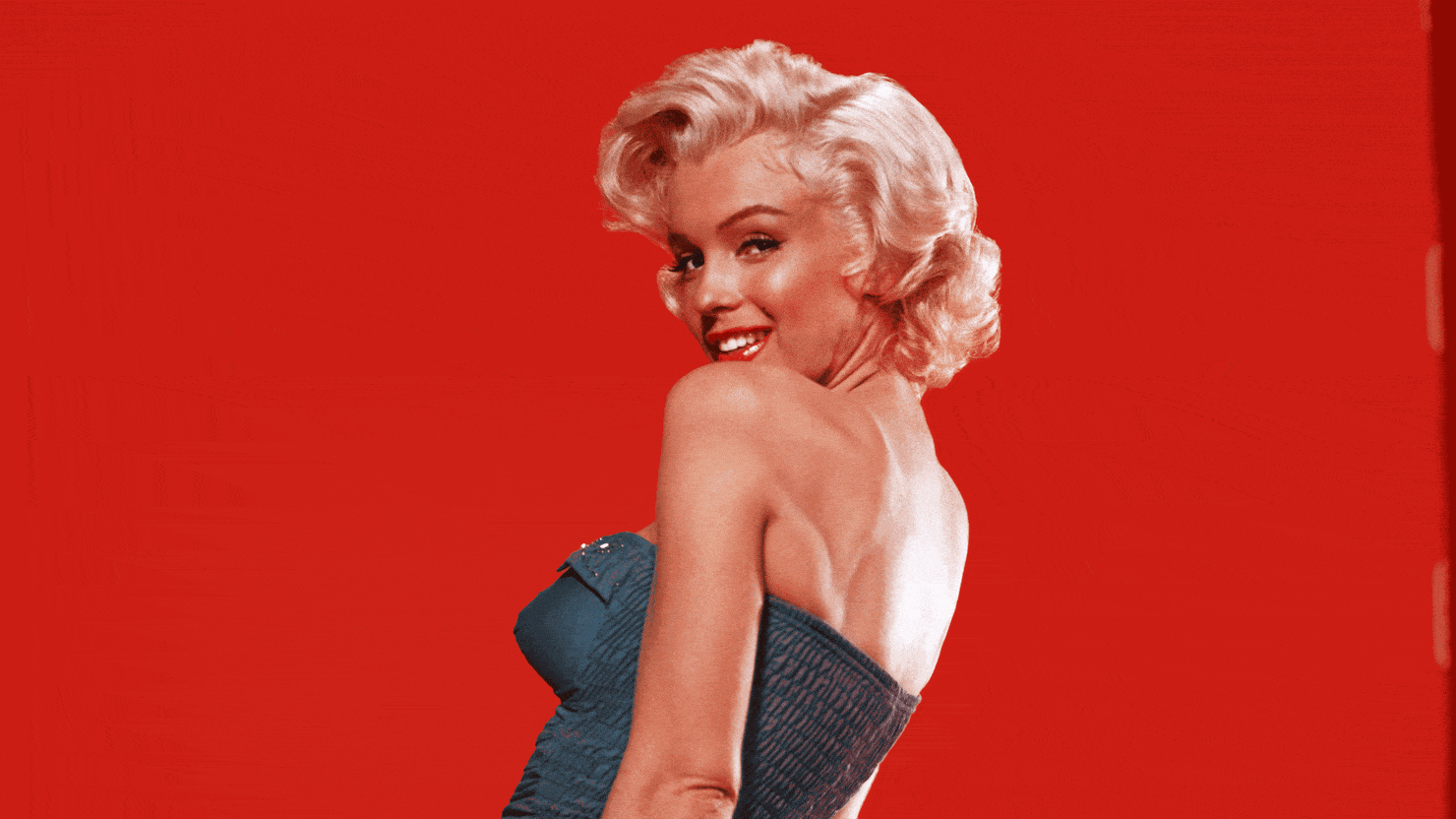Remember when Marilyn Monroe declared diamonds are a girl’s best friend?
 ]
]
Written by Megan C. Hills, CNN
Remember when showgirl Lorelei Lee left her fiancé dumbstruck as she emerged onstage in a pink satin gown, dripping in diamonds, in “Gentlemen Prefer Blondes”? Lee, played by Marilyn Monroe, then launches into a musical number where she croons “diamonds are a girl’s best friend” – a scene widely imitated in the decades since, from Madonna’s “Material Girl” video to Margot Robbie in “Birds of Prey.”
Equally unforgettable was Monroe’s strapless dress. Figure-hugging, paired with matching gloves and cinched with a giant pink and black bow, the look became one of Hollywood’s most iconic outfits after the film’s release in 1953.
But the outfit was, in fact, a last-minute alternative. The original – and far more revealing – costume was ditched because of a scandal involving nude photographs.
The pink satin gown has been widely imitated since it’s creation in the early 1950s. Credit: Allstar Picture Library Ltd./Alamy
Four years earlier Monroe, then an unknown jobbing actress, had posed naked for a photo shoot, earning just $50 for a series of images that would later feature in a calendar. Shot by pin-up photographer Tom Kelley, the photos showed the actress stretched artfully across red velvet sheets with her face tilted toward the camera, arms extended and toes pointed, creating beautiful lines.
In the four-part CNN docuseries “Reframed: Marilyn Monroe,” Monroe says she was assured by Kelley that nobody would recognize her. However, there was no mistaking her coiffed blonde curls and signature red lip in the smoldering photos.
By the time the calendar emerged in 1952, Monroe’s Hollywood profile had started to blossom. She was soon identified as the nude model, sparking backlash in conservative 1950s America and casting unflattering attention on the rising star. But Monroe overcame the incident and even gained sympathy through her unflinching honesty.
Hear Marilyn’s response when confronted about a nude photoshoot
“A few years ago, when I had no money for food or rent, a photographer I knew asked me to pose nude for an art calendar,” she told reporter Aline Mosby at United Press International.
Movie studio 20th Century Fox, which would release “Gentlemen Prefer Blondes” the next year, asked her to deny it was her. But she refused, explaining to Mosby: “Oh, the calendar’s hanging in all garages all over town. Why deny it? You can get one any place. Besides, I’m not ashamed of it. I’ve done nothing wrong.”
By owning the photos, she was able to control the narrative – and her public image – in the face of those trying to shame her.
“The nude calendar scandal really put her in the vanguard of the sexual revolution,” American literature professor Sarah Churchwell says in the new docuseries.
Last-minute controversy
Costume designer William “Billy” Travilla, who worked with Monroe on 11 movies including “Gentlemen Prefer Blondes,” later told cable network A&E that the photos sent the studio “wild.” Executives feared the images could ruin Monroe’s career and that the movie’s investors might pull out.
Initially, Travilla had been tasked with creating the “sexiest, most exciting, almost naked lady on the screen” – a very different look to the now-iconic satin pink gown.
Madonna referenced the ensemble in her 1985 music video for “Material Girl.” Credit: Alamy
“The costume was fishnet hose over her nude body,” he told A&E. “The breasts and the hipline (were) covered with diamonds put together by a jeweler. And just as we’re ready to shoot the number – good lord, the thing goes wrong. (A reprint of) Marilyn Monroe’s nude calendar hits the market.”
While Monroe was never filmed wearing the original outfit, rare test photographs of her wearing it do exist . Travilla said he had been instructed to “throw the costume out” by producers who feared they “might lose all the box office for the film.” Travilla then designed the pink gown, or a “very covered dress,” as a safer alternative.
The original sketch for Monroe’s iconic look designed by Travilla. Credit: William Travilla/Public Domain
However, the studio’s worries over the nude photographs were allayed when the film brought in $5.3 million at the box office, catapulting Monroe to full-blown stardom.
Another film starring Monroe, “How to Marry a Millionaire,” was released that same year, raking in another $8 million. As author Aubrey Solomon wrote in his history of 20th Century Fox, “In 1953, Fox’s two greatest assets were CinemaScope and Marilyn Monroe, in that order.” (Monroe, ironically, was only paid $500 a week for “Gentlemen Prefer Blondes,” she revealed in her final interview with Life Magazine in 1962, while co-star Jane Russell earned $200,000.)
Subverting ‘dumb blonde’ clichés
While it was only second choice, the pink dress has become a pop culture phenomenon, selling for $310,000 at a 2010 auction of Hollywood memorabilia.
Celebrities have also paid homage to the scene-stealing outfit and song. Some have emphasized the number’s obvious allusions to materialism, such as Madonna’s 1985 video for “Material Girl,” while others have turned it into an anthem for female empowerment, as Megan Thee Stallion and Normani did on their song “Diamonds.”
Normani wore a tighter, more revealing version of the floor-length gown. Credit: Megan Thee Stallion/Normani/Atlantic Records
Singers Ariana Grande, Camilla Cabello and Kylie Minogue have all channeled the gown for various performances, while James Franco even wore a version of it as co-host of the 2011 Oscars.
And movies like “Birds of Prey” (2020) and “Moulin Rouge” (2001) have offered darker references to the scene, with female protagonists struggling to secure their place in patriarchal societies. In “Birds of Prey,” the gown is reimagined as a jumpsuit worn by Harley Quinn (Margot Robbie) as she hallucinates an eerie version of the famous scene during a violent interrogation with crime lord Roman Sionis (Ewan McGregor). Sionis vastly underestimates Quinn as a “dumb blonde,” which proves to be his eventual undoing.
In 2011, Franco wore his own iteration while co-hosting the Oscars. Credit: Gary Hershorn/Reuters/Alamy
Shrewdly navigating her career, Monroe herself was anything but a “dumb blonde” – as she demonstrated with her handling of the nude photo scandal. In “Reframed: Marilyn Monroe,” Churchwell points to an unscripted line that Monroe came up with for her character, Lorelei Lee, and insisted on using: “I can be smart when it’s important, but most men don’t like it.”
What to watch this weekend: ‘Reframed: Marilyn Monroe’ on CNN
 ]
]
90 Day Fiance: Before the 90 Days (TLC at 8) Gino is worried that Jasmine is materialistic; Memphis isn’t happy with Hamza’s performance in the bedroom; Johnny’s family worries about him going to the U.S.; Ximena tells Mike a secret; Alina wants commitment from Caleb.
Behind a defining photoshoot for Marilyn Monroe
 ]
]
Clearfield, PA (16830)
Today
Snow during the morning will transition to snow showers during the afternoon. High around 30F. Winds WNW at 20 to 30 mph. Chance of snow 80%. About one inch of snow expected. Winds could occasionally gust over 40 mph..
Tonight
Overcast. A few flurries or snow showers possible. Low 21F. Winds WNW at 15 to 25 mph.
‘Yellowjackets’ finale, Remembering Marilyn Monroe, Bridget Everett Is ‘Somebody Somewhere,’ NFL Wild Card Weekend
 ]
]
We’re always interested in hearing about news in our community. Let us know what’s going on!
Go to form
CNN’s Marilyn Monroe Docuseries Is Ridiculously Reductive

Marilyn Monroe was a timeless beauty, a great movie star, a gifted comedian, and a complicated human being whose personal and professional struggles played out in the harsh glare of Hollywood’s spotlight. Reframed: Marilyn Monroe, however, cares little for Monroe’s complexity. Per its title, CNN’s four-part docuseries (Jan. 16) about the actress’ life and career aims to rewrite Monroe’s legacy, recasting her as a figure who wasn’t a passive, tragic victim but, instead, was a fighting feminist trailblazer who stood up to a misogynistic, paternalistic culture that sought to bring her low. That was, in part, true, although this non-fiction affair’s praise is so uniformly insistent that it ultimately plays as a one-note agenda-driven work intent on reimagining and celebrating the icon in inflated, and distinctly modern, #MeToo fashion.
This isn’t to say that Monroe wasn’t sometimes unfairly and disgustingly looked down upon, denigrated and mistreated during her stratospheric rise and premature fall, culminating with her 1962 death (due to a barbiturate overdose) at the age of 36. Rather, it’s that Reframed: Marilyn Monroe (narrated by Jessica Chastain) wants to forward a specific thesis, and spends its four installments doing nothing but restating it, transforming every single notable moment in Monroe’s life into an example of her strength, tenacity, shrewdness, independence, and “agency”—the last an incessantly heard term used to underline the idea that Monroe was in complete control of herself and her path at all times. Proactive self-sufficiency is the guiding theme of this endeavor, although it remains an inconsistent through line, since director Karen McGann’s portrait vacillates on a dime between damning a variety of men (and the systems they created) for harming Monroe, and contending that Monroe wasn’t truly victimized because she struck back at her oppressors at every turn.
Such confusion undermines much of Reframed: Marilyn Monroe, although its desire to recontextualize Monroe as a 21st-century feminist pioneer is clear from the get-go—and culminates with Amber Tamblyn claiming, at the conclusion of the final episode, that she thinks Monroe would have been on the frontlines of today’s activists and a big voice in the #MeToo movement. Whether that’s accurate or not, the urge to comprehend Monroe in contemporary progressive terms instead of on her own is this docuseries’ primary shortcoming. Without fail, Monroe’s every action is depicted as emblematic of her determination, talent, and intelligence, including her setbacks, which are creatively cast as indicators of her defiance, resolve, and bravery. In this perspective, Monroe suffered no real failures or made any mistakes; her every move was an expression of her enlightened skill and genius.
Reframed: Marilyn Monroe purports to see Monroe as she truly was, divorced from the misogyny of the era. Yet it’s so consumed with dispensing a specific kind of veneration that it winds up being unpersuasive, even when its particulars—and its analysis of those points—are on-point.
Buoyed by photographs, film and press clips, and audio interviews with Monroe, director McGann’s investigation traces Monroe’s journey from aspiring contract-player starlet to leading lady—a trajectory that included clashes with Twentieth Century Fox head honcho Darryl F. Zanuck, a relationship with Columbia Pictures bigwig Harry Cohn, and an eventual fight to create her own production company that would grant her the power to choose a broader array of roles, as well as her scripts and directors. For those who don’t know anything about Monroe’s tale, this material is covered briskly and with requisite drama. It’s also embellished by commentary from a collection of talking heads, be it actresses Ellen Burstyn and Mira Sorvino, biographer Cindy De La Hoz, film critics Angelica Jade Bastien and Christina Newland, or American literature professor Sarah Churchwell, whose book The Many Lives of Marilyn Monroe is the basis for this effort, and who does the most heavy lifting in the overstating-things department.
Viewing Monroe in a novel light, free from the sexist attitudes and assumptions of old, is a noble and worthwhile aim, but Reframed: Marilyn Monroe doesn’t serve its subject well by reconfiguring her story to be unwaveringly flattering. According to those featured in the docuseries, Monroe was the real artist behind her memorable snapshots (the photographer was merely a functionary); she was her own best, strategic publicist; her USO tours were proof of her immense care for others and her political awareness; her love and support of Ella Fitzgerald showed she was an ahead-of-her-time civil rights hero; and her third husband Arthur Miller’s defiant stand against the House Un-American Activities Committee was actually Monroe’s idea.
“ Viewing Monroe in a novel light, free from the sexist attitudes and assumptions of old, is a noble and worthwhile aim, but Reframed: Marilyn Monroe doesn’t serve its subject well by reconfiguring her story to be unwaveringly flattering. ”
On and on it goes, with people talking about how they want to know Monroe as a three-dimensional person even as they render her a radiant object onto which they can project their own timely politicized opinions. Tamblyn refers to her as “an original Kardashian” for knowing how to manipulate, and wow, the press, while other speakers bandy about phrases like “the male gaze” and “sexual economics.” No matter how relevant or apt some of these notions may be, Reframed: Marilyn Monroe has no interest in wrestling with the reality of the actress and her ups and downs, too busy is it promoting a vision that suits its own needs. For it, Monroe can’t simply be a luminous movie star; she has to also be a titanic artist. She can’t just be a canny media celebrity; she has to be a tactical mastermind. And she can’t have been someone who, in her later years, needed help; she was always a strong, fearless warrior who pushed back against a chauvinistic status quo that sought to reduce her to merely a platinum-blonde pin-up, even as she wielded her sex appeal for empowering ends.
Doggedly laudatory, Reframed: Marilyn Monroe fails to impart a genuine sense of who Monroe was; it replaces one mythic interpretation of her for another. Course-correcting to an excessive degree, it avoids grappling with the messiness of its subject in favor of turning her into a simplistic symbol of modern womanhood, and the continuing fight for female equality. In trying to expand our understanding, it proves frustratingly reductive.
